Just finished watching the Dust Bowl on PBS and saw the effects of plowing, draught, and wind. I don't farm so I don't know how most in farming prepare the soil for planting but around here, mid-Michigan, no-till drilling and not plowing appears routine. That's according to our local elevator owners. I notice that the photo ads on this YT site always have many plows for sale every day. Are plows a relic of our past and only have sentimental value or do they really command the prices that are being asked?
You are using an out of date browser. It may not display this or other websites correctly.
You should upgrade or use an alternative browser.
You should upgrade or use an alternative browser.
- Thread starter Joe W.
- Start date
Erik Ks farmer
Well-known Member
There is still a place for the plow, today for instance I plowed up terraces, the majority of the field will be no tilled, but the plow throws the dirt up to help rebuild the terrace and maintain the channel to allow water to drain properly. So in this instance it is a conservation tool.
onefarmer
Well-known Member
- Location
- 6735 S Lowell Rd, St Johns, Mi 48879
Since I don't have anything to plant no-till, I still plow sod and corn stalk ground. Beans get run over with the disk and then field cultivator.
uncle henry
Member
my friend has three terrace plows and two for parts
buickanddeere
Well-known Member
In heavy soil where a hard pan bottom forms and when the soil becomes compacted. The soil must be V-ripped on occasion. With moldboard ploughing or true deep chisel ploughing at least every 2-3 years.
The rain water used to puddle on the surface of my fields. Until moldboard ploughing them after decades of no till/limited till.
The rain water used to puddle on the surface of my fields. Until moldboard ploughing them after decades of no till/limited till.
Traditional Farmer
Well-known Member
- Location
- Virginia
The turnplow is like Freddy link_disallowed about the time you think they're gone they make a comeback
Bruce from Can.
Well-known Member
- Location
- Woodville, Ontario, Canada
I plough some chisel some , depends on the field and what grew there last. We have some clay in our dirt, and lots of cow manure to work in, so it still works for me. Bruce
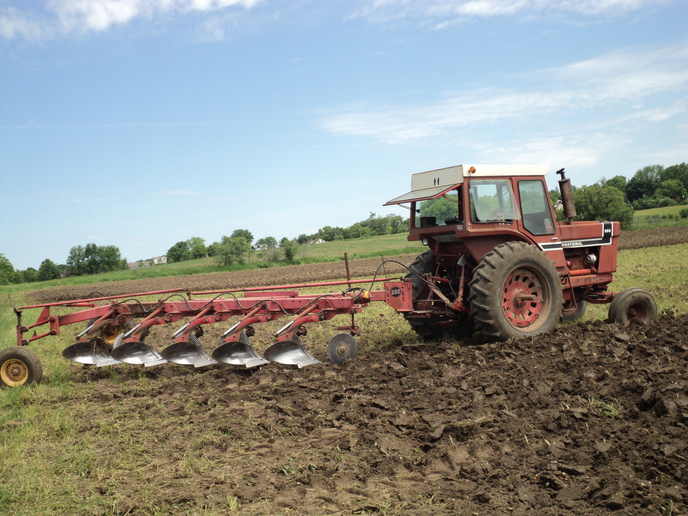
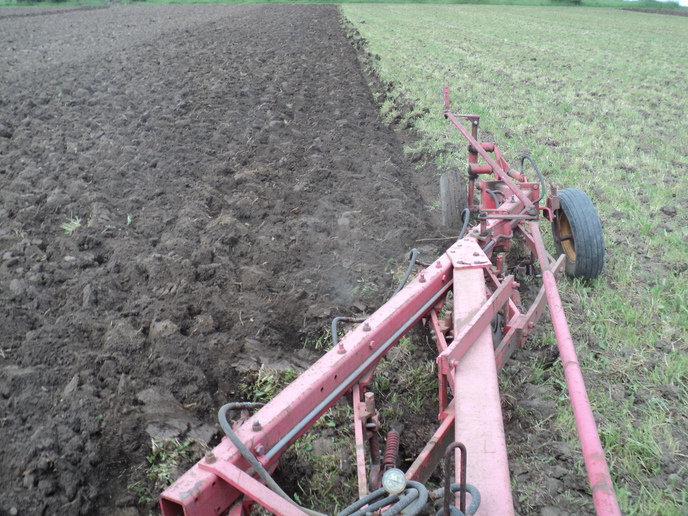


Plowing is more of a regional thing now days. No one plows here, not even chisel plowing, save for a few nostalgia buffs. With our soil structure, no till is by far the best yielding, best under drought conditions, most profitable, best use of time. A few folks are beginning to embrace the advantages of no tilling a deep rooting cover crop to help add organic matter, to help bring up nutrients that have leached their way deeper into the soil, and to help break compaction. The trick is to minimize compaction as you go along.
Most of my ground has been no tilled for near 35 years now. Where once you had a hard time shoving a soil probe more than 10" into the ground, now it's easy to go 20" or more. (Beyond that, you'll likely get into what we call "blue clay" then limestone bedrock.)
Corn tends to root deeper until it hits a change in soil density. If it finds that difference at 6", or 10" or whatever the case may be, it starts to root mostly parallel with the surface instead of going down. With no till (done properly) their is minimal change in soil density, causing healthy corn to root far deeper than in tilled soils. Not a big deal in years where we get plenty of rain throughout the growing season, but in a dry year, you see the advantages.
Ground that's been in no till (and properly done so) around these parts absorbs rain like a sponge, where it held water on the surface back in the day when we plowed everything. No tilling requires that you embrace ALL the technology and practices that make it work, or you just don't get the desired results
With the high residue left behind todays corn hybrids, some farmers are resorting to moldboard plowing to bury some of that trash. In this immediate area, a few more forward thinking no till farmers have gone to a version of vertical tillage tool that shred residue but only work the soil maybe an inch or two. Since planters place seed at or below that depth, the corn plants don't find a change in soil density.
So. Plows are for the most part parked in the fence rows in this part of the world.
Most of my ground has been no tilled for near 35 years now. Where once you had a hard time shoving a soil probe more than 10" into the ground, now it's easy to go 20" or more. (Beyond that, you'll likely get into what we call "blue clay" then limestone bedrock.)
Corn tends to root deeper until it hits a change in soil density. If it finds that difference at 6", or 10" or whatever the case may be, it starts to root mostly parallel with the surface instead of going down. With no till (done properly) their is minimal change in soil density, causing healthy corn to root far deeper than in tilled soils. Not a big deal in years where we get plenty of rain throughout the growing season, but in a dry year, you see the advantages.
Ground that's been in no till (and properly done so) around these parts absorbs rain like a sponge, where it held water on the surface back in the day when we plowed everything. No tilling requires that you embrace ALL the technology and practices that make it work, or you just don't get the desired results
With the high residue left behind todays corn hybrids, some farmers are resorting to moldboard plowing to bury some of that trash. In this immediate area, a few more forward thinking no till farmers have gone to a version of vertical tillage tool that shred residue but only work the soil maybe an inch or two. Since planters place seed at or below that depth, the corn plants don't find a change in soil density.
So. Plows are for the most part parked in the fence rows in this part of the world.
Ken Macfarlane
Well-known Member
It's hard to Fix rough ground without a plow. I'm plowing some old fields now that are rougher than he double l to put them back into production.
Stephen Newell
Well-known Member
I'm not a farmer but I was wondering with no-till how do you keep weeds and grasses from overtaking the crops?
Anonymous-0
Well-known Member
I grew up in east central Indiana and farmed there so I am familiar with Michigan. Your soil is most likely sandy and dry so no till best option to maintain moisture. We transistioned to no till in the 90s and had same results as post below with overall improvement in the ground and softning of the clay. No till will make you farm smart, if you don't do it exactly right crop will fail. If you do it right crops will be better than conventional. Takes a lot of patience and you cannot push the weather when planting.
Phil in Pa
Member
When I was a kid in the 70's we moldboarded everything. At that time, it was mostly smaller 100-200 acre farms.
By the late 80's the BTO's were farming nearly everything with chisels, then discs, and now a lot of no-till.
I only see moldboard plowing done on some vegetable farms now. Too bad, I thought it was one of the most fun field jobs. Wish we had taken ear plugs seriously back then.
By the late 80's the BTO's were farming nearly everything with chisels, then discs, and now a lot of no-till.
I only see moldboard plowing done on some vegetable farms now. Too bad, I thought it was one of the most fun field jobs. Wish we had taken ear plugs seriously back then.
Very little moldboard plowing done here and pretty much done by the Mennonites and Amish. I do sort of a minimum till with an offset disk. Last year I did some chisel plowing. My only regret is I am too small to afford the tools necessary to no-till. I do have a deep till but find the action of it too aggressive. A strip-till would probably be more appropriate especially in the spring but they are too new to find anything used. Even well drained fields on my farm can be too wet to use a no-till drill in a wet spring so I still have to have a field cultivator (which I am upgrading) and some other conventional tools to air and warm the soil. Fields that run wet in a normal year need to be artificially drained for good results in no-till.
Plows have madea big comback here on clay, wet, cold soils of southern MN. See new ones at farm shows, and good used bring double what they did 15 years ago.
It's gonna depend on your soil and climate.
Less tillage is _great_ if you can do so. The arid ground, like in the dust bowl, shouldn't be plowed so heavily.
But not one size fits all.
'Here' in these wet, cold, clay soils, plowing works well. Our ground is froze solid 5 months over winter, and under snow. It doesn't break down, or blow, or wash away like soils to the south of us do. We typically need to get rid of excess moisture here, not try to keep spring moisture. We have frost up to 4 feet deep, we need the weak spring sun to hit black dirt and warm it up. It's become common to plant corn with frost still in the ground - if we can get the top foot of ground to warm up and dry off some, we can get an early start to corn & get higher yields, which means lower cost food for all of you.
Likewise, many insect, weed, and fungus issues are much easier to control or eliminate with heavy tillage, such as plowing. We see more and more corn borers, ear bugs, Goss' Wilt, and so forth as we do less and less tillage. The Roundup resistant weeds are much worse in the low to no tillage areas.
So, a good plow is _not_ the thing to use in arid, warm, southern climates!
But it is the best tool to use in other areas.
I hope folks don't get on some sort of bandwagon, and insist we all must comply, and pass laws that certain farm proactices are banned all across the nation, when such a thing is foolish.
We need to use the best tools for the local conditions.
In some areas, that means no plows in some areas; and lots of plowing in other areas.
I live in one of those areas where a plow, or other deep heavy fall tillage, is typically thr best option to provide good soil management and cheapest, most food supply.
One size does not fit all.
--->Paul
It's gonna depend on your soil and climate.
Less tillage is _great_ if you can do so. The arid ground, like in the dust bowl, shouldn't be plowed so heavily.
But not one size fits all.
'Here' in these wet, cold, clay soils, plowing works well. Our ground is froze solid 5 months over winter, and under snow. It doesn't break down, or blow, or wash away like soils to the south of us do. We typically need to get rid of excess moisture here, not try to keep spring moisture. We have frost up to 4 feet deep, we need the weak spring sun to hit black dirt and warm it up. It's become common to plant corn with frost still in the ground - if we can get the top foot of ground to warm up and dry off some, we can get an early start to corn & get higher yields, which means lower cost food for all of you.
Likewise, many insect, weed, and fungus issues are much easier to control or eliminate with heavy tillage, such as plowing. We see more and more corn borers, ear bugs, Goss' Wilt, and so forth as we do less and less tillage. The Roundup resistant weeds are much worse in the low to no tillage areas.
So, a good plow is _not_ the thing to use in arid, warm, southern climates!
But it is the best tool to use in other areas.
I hope folks don't get on some sort of bandwagon, and insist we all must comply, and pass laws that certain farm proactices are banned all across the nation, when such a thing is foolish.
We need to use the best tools for the local conditions.
In some areas, that means no plows in some areas; and lots of plowing in other areas.
I live in one of those areas where a plow, or other deep heavy fall tillage, is typically thr best option to provide good soil management and cheapest, most food supply.
One size does not fit all.
--->Paul
Not obselete in the UK , We have to plough for drainage and to keep weeds at bay. This is my 13 year old son ploughing a neighbours small field with my 3 furrow reversible plough, our ground is steep and heavy and most times we could handle 4 furrows but then I don't plough much anymore so it has to do!
In England where the fields are larger they still plough but on the flat land they can handle many more furrows, The other photos are from a couple of dealers yards I visited last week. Our ploughs are all reversible and have been since around 1980
Sam
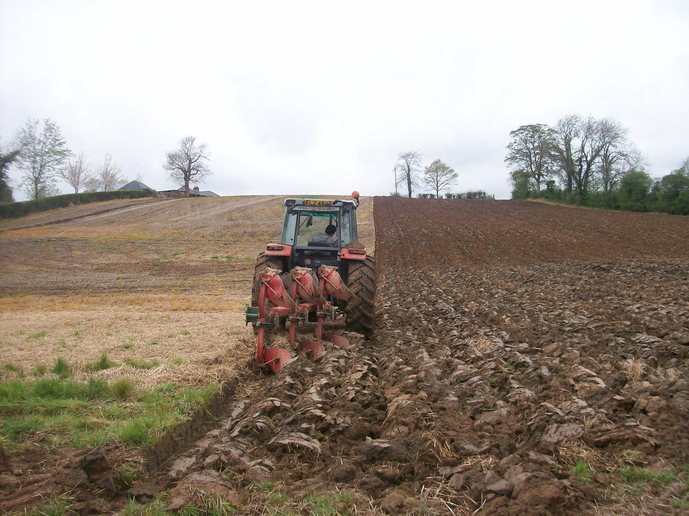
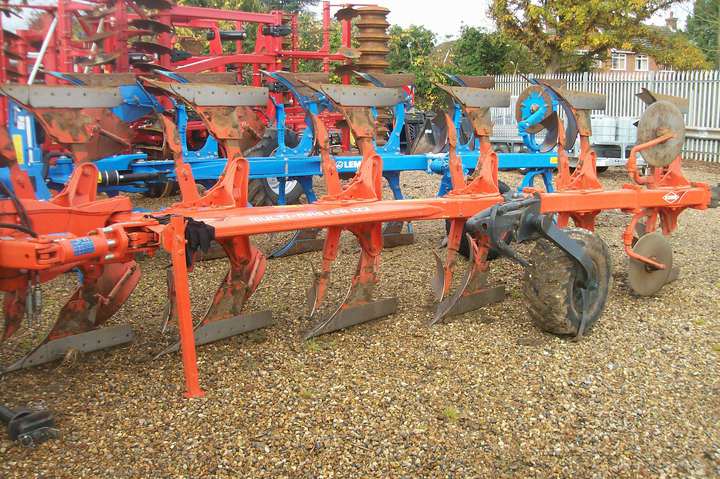
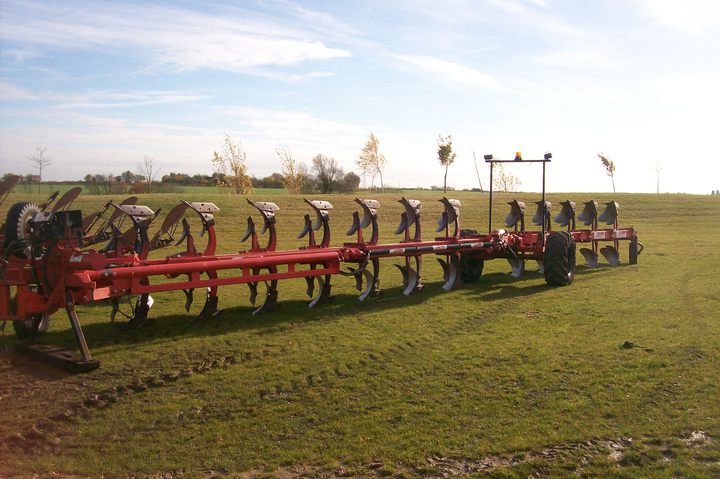
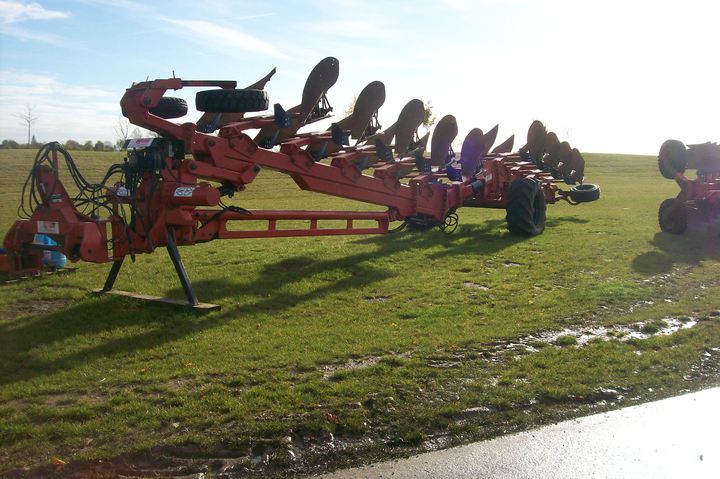
In England where the fields are larger they still plough but on the flat land they can handle many more furrows, The other photos are from a couple of dealers yards I visited last week. Our ploughs are all reversible and have been since around 1980
Sam




When we have a plow play day here in Illinois USA we don't use the mold board plows. No one wants the furrows to contend with next year and not all the plows pull the same and the whole field ends up being plowed at different depths. So we just use one or two bottom rippers.
Its still fairly popular here, though I see most corn ground they may use a heavy disc, not plow every year, anything sod bound, hay, alfalfa or similar, it seems the moldboard plow has its purpose, I am not sure about compaction issues and plow depths or what the concerns are, large operators seem to use other tillage tools, but most seem to have a moldboard plow in their shed or equipment yard.
Anonymous-0
Well-known Member
I rented a 320 accross the road from me-It had been no-tilled for 6 or 7 years before me. The previous renter signed off so I could do fall tillage. At the time I had a Steiger 4wd and a 13 shanks Glencoe soil saver. I pulled into farm after doing mine and let the ss down---I thought what the heck is wrong with this tractor!! I had to drop down a gear-now I knew why after a rain water always sat between the rows-harder than a rock. I rented this farm 50-50- The following fall the landlord said he got almost twice as much crop to town as he did with previous renter. I still play with a 22 acre field north of my place-no one can see it from the road-side by side notill beans vs ss tilled 8.4 bu differance! Around here when we talk notill we say NOTILLING who will farm it next year!!!
USAonly, there are often discussions on tillage vs notill over on NAT, a farm discussion site.
Your comments mirror how things are here where I live, but man, your comments would get you strung up over there, no-tillers can walk on water, and their way is the only way, youcan't say you get better yields with a plow or heavy tillage implement!

I just got a Soil Saver this fall, and worked up my bean stubble. Could sure feel the hardpan in some areas that are typically wet for me. I've done a lot of tiling the past 4 years, see if those low hard clay areas dry out better, and with the deeper tillage, see if my yields come up some. On a dry period like the last 2, it's really important to get the low spots to grow well, when the high spots get dry and thing, the low areas need to have everything go right.
I end up with some of the least tillage in my county, with the 40 acres I let the cattle graze all winter, dealing with the spring cornstalks is a challenge with only spring tillage. Some years it goes well, some years those 40 acres are just a disaster in my conditions, and shows how bad notill would be 'here'. I wish it would work, love to save the fuel and time used to work up the ground, but if you want a crop, you need to prepare a good seedbed.
Maybe some day they will get strip till prefected enough to work here.
--->Paul
Your comments mirror how things are here where I live, but man, your comments would get you strung up over there, no-tillers can walk on water, and their way is the only way, youcan't say you get better yields with a plow or heavy tillage implement!
I just got a Soil Saver this fall, and worked up my bean stubble. Could sure feel the hardpan in some areas that are typically wet for me. I've done a lot of tiling the past 4 years, see if those low hard clay areas dry out better, and with the deeper tillage, see if my yields come up some. On a dry period like the last 2, it's really important to get the low spots to grow well, when the high spots get dry and thing, the low areas need to have everything go right.
I end up with some of the least tillage in my county, with the 40 acres I let the cattle graze all winter, dealing with the spring cornstalks is a challenge with only spring tillage. Some years it goes well, some years those 40 acres are just a disaster in my conditions, and shows how bad notill would be 'here'. I wish it would work, love to save the fuel and time used to work up the ground, but if you want a crop, you need to prepare a good seedbed.
Maybe some day they will get strip till prefected enough to work here.
--->Paul
I live in the heart of area most commonly called the Dust Bowl and the main reason you have to be careful plowing out here is because precipitation is so scarce and unpredictable, if you plow the the trash in, you might not have enough cover to keep the soil from blowing.
I only farm 80 acres now, but the first year I took that place over, the guy before me had oneway disced all the cover under and then I didn't get enough moisture to even come close to sprouting the wheat I planted. I fought all winter to keep it from blowing - including one giant windstorm that had just a sprinkling of rain mixed with it... After that storm, my Dad's place right across the road (barns, house, trucks, tractors, etc) looked like everything was made out of chocolate adobe with 1/4 inch of soil plastered all over.
For the most part, the guys irrigating corn, etc, under center pivots still plow heavily with DMIs, chisels, etc...
But almost no dryland out in this area is plowed anymore.
But to your comment about prices, the scrappers, deer plot farmers, & guys hauling all the small stuff off to Mexico are keeping implements prices pretty strong...
Howard
Hope not. I plowed almost all of my corn ground this year. I hauled a lot of pen manure and needed to get it turned under. It made a heck of a difference in the low spots. I chisel good and deep too,but those low spots where the corn usually drops off short,it was taller than the rest of the fields this year. I don't think it hurts a thing to get that ground turned over once and a while. I don't plan to do it every year,but now and then.
I plow my alfalfa sod under when I rotate back to corn,but normally just chisel the second year. Going to oats and alfalfa,depends on how much time I have in the spring. If I have a few extra days of good weather,I prefer to plow it.
I plow my alfalfa sod under when I rotate back to corn,but normally just chisel the second year. Going to oats and alfalfa,depends on how much time I have in the spring. If I have a few extra days of good weather,I prefer to plow it.
A farmer has to be careful here with fall tillage. It works best with a mild freeze followed by a cover of snow. During the 1980's we had several open dry winters and the ground was rock hard and extra dry come spring planting time. The more loamy soils were much more tolerant to laying open for extended periods. As RR Lund would say I don't know if the Indians would want a lot of my ground back.
Will Herring
Well-known Member
About all we use plows for is for our gardens. Hard to no till that, haha.
Todd,
All depends what part of Mid Michigan. Where I am at, we are heavy clay. I sometimes wonder if I should make bricks instead of growing trees.
My property has been farmed over 100 years, it has around 12 inches of "soil", then pure clay as deep as you want to dig, it changes from yellow to blue clay around 5 feet down.
I say "soil" because it is not rich, black dirt like I have seen elsewhere. Its more clayish with a 100 years of residue decomposed in it. I even live in Clayton Township.
Rick
All depends what part of Mid Michigan. Where I am at, we are heavy clay. I sometimes wonder if I should make bricks instead of growing trees.
My property has been farmed over 100 years, it has around 12 inches of "soil", then pure clay as deep as you want to dig, it changes from yellow to blue clay around 5 feet down.
I say "soil" because it is not rich, black dirt like I have seen elsewhere. Its more clayish with a 100 years of residue decomposed in it. I even live in Clayton Township.
Rick
Loren in WI
Member
My dad grew up in easrern NE. Then we moved to WI. In Nebraska it was always so dry. Then came the center pivot Irrigation. Several wells that my relatives had out there for years have dried up, as they said the water level is going down, around 50 feet so far. In Wi it was a wetter climate, we moldboard plow all the time. I remember when no till corn came out the fine print said you only need to plow every 7 years. Well 25 years later some just chisle plow. I have seen corn stalks that are so hard 4 years later they havent rotted down yet. That is I we plow, it covers up the stalks and makes organic matter. I think land still needs to be plowed but keep buffer zones and fence rows to keep some vegetation there.
Similar threads
- Replies
- 14
- Views
- 1K
- Replies
- 40
- Views
- 3K
We sell tractor parts! We have the parts you need to repair your tractor - the right parts. Our low prices and years of research make us your best choice when you need parts. Shop Online Today.
Copyright © 1997-2024 Yesterday's Tractor Co.
All Rights Reserved. Reproduction of any part of this website, including design and content, without written permission is strictly prohibited. Trade Marks and Trade Names contained and used in this Website are those of others, and are used in this Website in a descriptive sense to refer to the products of others. Use of this Web site constitutes acceptance of our User Agreement and Privacy Policy TRADEMARK DISCLAIMER: Tradenames and Trademarks referred to within Yesterday's Tractor Co. products and within the Yesterday's Tractor Co. websites are the property of their respective trademark holders. None of these trademark holders are affiliated with Yesterday's Tractor Co., our products, or our website nor are we sponsored by them. John Deere and its logos are the registered trademarks of the John Deere Corporation. Agco, Agco Allis, White, Massey Ferguson and their logos are the registered trademarks of AGCO Corporation. Case, Case-IH, Farmall, International Harvester, New Holland and their logos are registered trademarks of CNH Global N.V.
Yesterday's Tractors - Antique Tractor Headquarters
Website Accessibility Policy

